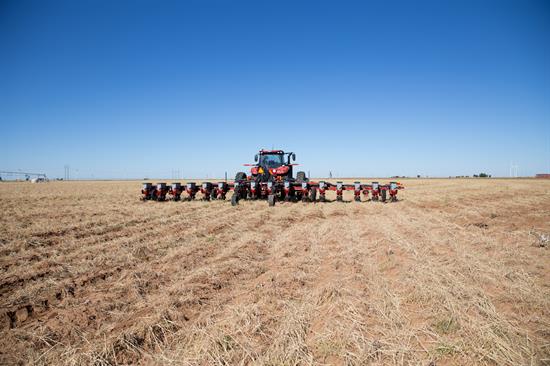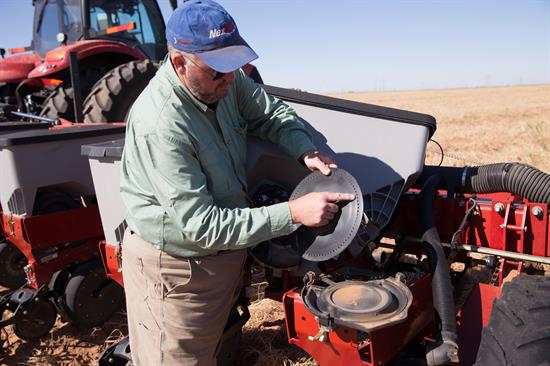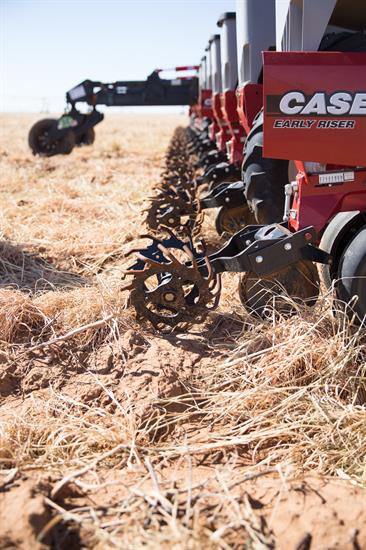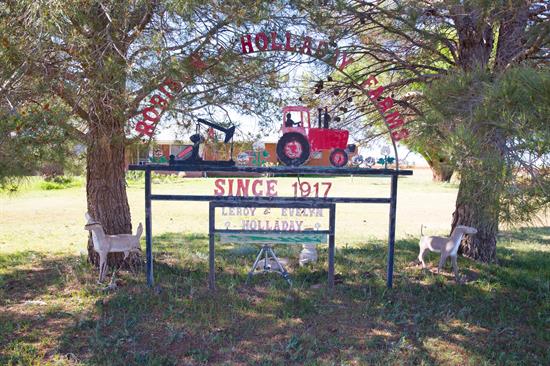Most people would look at this photo and see a dry, dusty field in the middle of nowhere. But to Shawn Holladay, this field represents generations of his family, his livelihood, and decades of hard work and careful attention. This is largely what cotton country looks like in the spring, where acres upon acres of fields have been primed over the winter months in preparation of planting.
Shawn Holladay is a fourth-generation farmer in Dawson and Martin Counties in Texas, farming on the same land his father, grandfather, great-grandfather, and now wife and daughter work – making it a five-generation operation. Shawn and his family live in Lubbock and farm in Lamesa, a small farming town south of Lubbock where Shawn has worked his whole life. Some of his earliest memories involve riding and driving tractors with his father, Grant, and grandfather, Leroy.
He said, “I’ve been on the farm every year of my life and driving tractors since I was 11. I was basically a farmhand for years before I came back from college to help run it with my dad.” Shawn never doubted he would follow in their footsteps, and today it truly remains a family-run farm with the help of his wife, Julie, and daughter, Katy, who do everything from hands-on field work, to computer work with GPS systems, to administrative work like billing and payroll.
“Julie and Katy are a huge part of our business, and they keep the wheels running. It takes a lot of work to manage all of our paperwork and accounts, but when we need more hands to help in our busier times, they’re also in the field.” Katy is a student at Texas Tech University, and Julie serves on The Cotton Board, as well as numerous community organizations.
What was once a small-scale farm has grown to a 9,800 acre operation, with 8,500 acres of cotton and 1,300 acres of peanuts. While his daily schedule varies depending on the season, Shawn’s longest work days are during the planting and harvest seasons.
“From May until July 4, it’s crazy out here. It’s the most volatile weather, so we’re planting, replanting, and trying to save stuff from the wind. You’re like a hamster on a wheel for 30 to 45 days, working unreasonable hours,” he said. During planting season, Shawn’s father, who still drives a tractor and helps throughout the year, meets him at the barn every morning at 7am, and they work until 10pm every day. They have several full-time employees who work year-round and are especially helpful when it comes to maintenance on their equipment.
After last year’s harvest, Shawn took several steps to prepare the soil again for planting. Farmers have several options for tillage, and Shawn uses different practices that are best suited for specific land. On his irrigated land, he uses minimum tillage in conjunction with cover crops. He will plant wheat or rye after harvesting the previous year’s crop. This process revitalizes the soil and prepares it for another season of growing cotton or peanuts. With minimum tillage, Shawn can plant directly over the cover crops.
Given the limited rainfall in West Texas, Shawn uses conventional tillage practices on his non-irrigated land or dryland. First, he runs a chisel plow to break up compaction in the soil. Weeks later, he will take a field cultivator back over the fields to turn the soil, and lastly “beds” the fields, which involves forming rows of seed-beds for planting. After these steps, his fields are ready for planting.
Shawn typically runs six tractors when planting, with four or five pulling planters. Mechanical planters can cover up to 24 rows, though it’s more common to see 8-row planters in West Texas. Shawn uses an impressive 16-row precision planter on his flatland acres, which places cotton seeds at a uniform depth and interval. He uses 8-row planters on terraced and contoured land, which is land that is sloped either due to certain farming techniques or uneven terrain. Terraces and contour farming are common sights on the Texas High Plains. These water conservation practices help to hold rainfall on the field, rather than see it run down the turnrow. Once planting is done, it takes five to 10 days for seedlings to emerge from the soil, but it will take a couple of months for flower buds to appear.
Farmers are eternal optimists who must take a leap of faith every year. They are unable to control most of the factors that can devastate their businesses – like the weather, low commodity prices, unpredictable swings in financial markets, and instability in the global marketplace. In West Texas, the land is flat, and the air is hot and dry. This region is prone to drought and severe weather, both of which can be devastating to crops. In 2011, there was not a single measurable rain shower in Lamesa, and much of Texas was in a years-long drought. Then in 2015, Shawn’s land received 30 inches of rain over the course of three weeks, and he is still repairing land from that flood. The extremes – on either end of the spectrum – are dangerous and can be catastrophic.
He said, “Trust me, what Mother Nature can throw at a guy is clear to a family that has farmed mostly dryland cotton in West Texas for four generations. Thanks to the good Lord smiling on us every now and again and crop insurance, we have been able to get through tough times.”
Shawn, like most farmers around the country, depends on crop insurance to protect his business in times of drought, severe weather events, or other conditions that result in crop loss. Without this tool, farmers would not be able to secure the necessary financing to grow food and fiber – a risk farmers take year after year.
Times are especially tough for cotton farmers right now, with many families facing the real possibility of going out of business. Crop prices are down sharply, input costs are rising, and American cotton is at a major disadvantage in the global market because of huge foreign subsidies, tariffs, and non-tariff trade barriers on the rise.
“I’ve been out here all my life, and there have been two times I’ve looked at doing other things because I didn’t know if this was going to work, and one of those times is right now. Everyone says ‘It will be okay,’ but once you lose cotton, you don’t get it back. Mother Nature can kick in and do well for you, but we can’t have other people manipulate our markets and give it away every year.”
The state of the farm economy is particularly worrisome to Texas farmers and the rural communities that depend on the cotton industry, as it is the largest cotton producing state in the nation, and cotton is Texas’ highest valued cash commodity.
Within the last few days, Shawn has wrapped up his seed planting as he begins yet another year of dutifully growing food and fiber for our nation. We look forward to following his crops’ progress and the challenges he faces both on and off the farm.
|
|
|
|
| Precision meter that holds and releases one seed at a time |
|
|
|
| A field in Lamesa a few weeks before planting |
|
|





